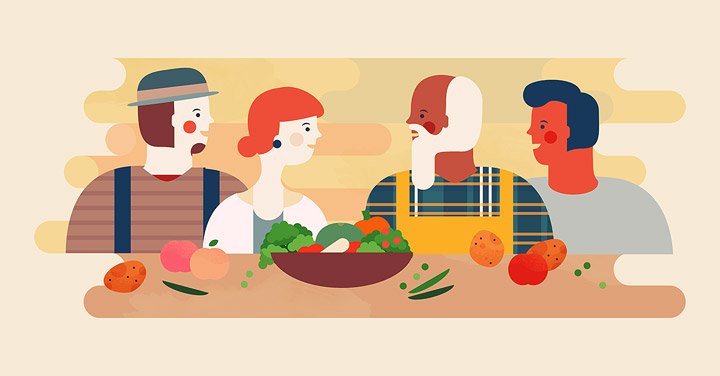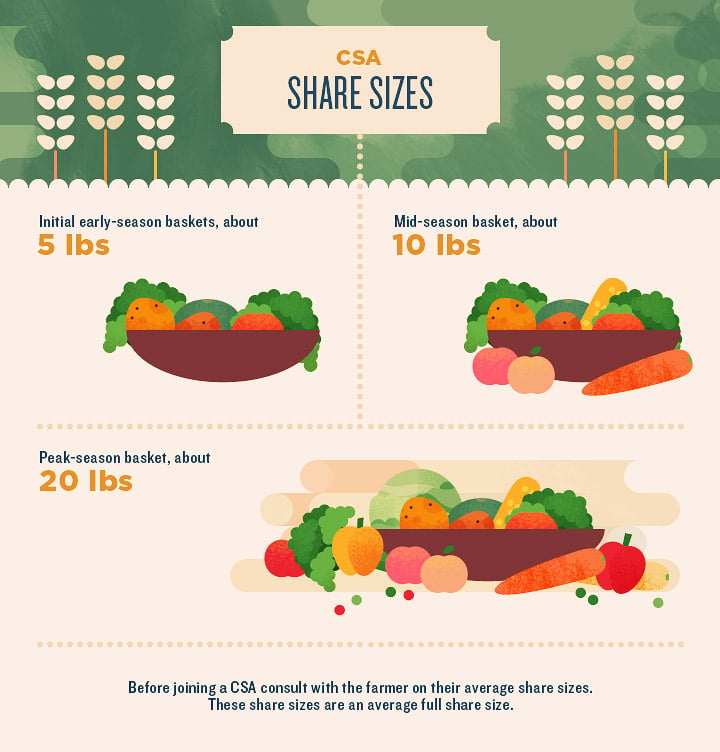This article was originally published on CustomMade.com.
Community Supported Agriculture is having its moment. Across the country, more and more people are signing up for farm shares, looking to benefit from a sense of community, healthier environments, and fresh, wholesome food. But despite its increasing popularity, community supported agriculture is still hardly a common term at every dinner table.
If you’ve been wondering what a community supported agriculture membership is or whether you should join one, or if you’ve already joined and want to know how to get the most from your weekly share, this guide will help you discover the ins and outs of CSAs and how to make a membership work best for you.
What is Community Supported Agriculture?
Community supported agriculture (CSA) allows people to purchase seasonal produce directly from a local farmer. The farm offers a certain number of “shares” to the public and commits to grow food for participating members. In turn, community members agree to support the farm through financial contributions, which are typically paid up-front before the growing season. Membership dues help to pay for seeds and plants, greenhouse expenses, equipment, labor, and other items related to the workings of the farm. Members then receive a weekly or bi-weekly share of the farm’s harvest—essentially, the community members become shareholders of the farm. To date, tens of thousands of families have joined more than 4,000 CSAs across the U.S.
The benefits of CSAs are numerous. CSAs promote sustainable land management and farming practices, reduce participating members’ food transportation needs, support local commerce, provide farmers with financial security, offer consumers access to healthy, fresh food, and allow communities to build mutually supportive relationships.
Variations on the CSA Concept
CSAs began in Japan in the mid-1960s and 1970s; consumers were concerned with the increasing use of pesticides in industrial farming, and European biodynamic agriculture was exploding, too. The concept of subscription farming made its way to the U.S. in the mid-1980s.
Since then, different farms and communities across the country have tailored the same model to their own needs and preferences. CSAs can operate on vastly different scales, with some serving just 20 families and others providing food for over 1,000 households. CSAs offer delivery options or distribute shares at farmers’ markets, or require members to pick up their shares directly at the farm. Members at some farms choose what kinds of produce are included in their share each week, while other farms let the week’s harvest to dictate what will be included. Many farms exclusively distribute vegetables and fruits; others include additional foodstuffs such as eggs, bread, meat, flowers, or dairy products. At some farms, members may work on the farm in exchange for part or all of a share; other farms offer only a cash-for-food exchange.
A partnership between two farms—for example, a vegetable farmer might partner with a chicken farmer—is increasingly popular; it allows them both to meet more of their consumers’ needs. Other farms have created specialized CSAs devoted exclusively to meat, flowers, or preserved products. And in some areas of the country, third parties have established CSA-like businesses in which they sell boxes of food to their members but do not produce the food themselves.
Despite all variations, the basic concept behind CSAs remains the same: Create community, benefit farmers and the environment, and provide consumers with healthy, flavorful food.
How to Get the Most Out of a Membership
Interested in joining a CSA? Keep these tips in mind to maximize your experience.
Before You Join
Depending on products offered and frequency, a season’s CSA share can cost hundreds of dollars, While the cost can easily pay for itself in food and community benefits, it’s a big enough investment that it’s worth considering whether a CSA is right for you. Keep the following considerations in mind.
- No harvest is guaranteed. CSA members share in the risks inherent to farming. This may include poor harvests due to pests or bad weather.
- The farmer matters. Remember: Joining a CSA means joining a community. You’ll have an ongoing relationship with your farmer, so positive rapport is important. If you can, schedule a meet-and-greet so you can get to know your farmers in person and understand their approach to risks and shareholder needs. Also ask for references from other shareholders.
- Cooking is required.A CSA share will offer up a variety of fresh, unprocessed foods that may require prep and will need to be cooked within the week (generally) in order to prevent spoilage. View this as an opportunity to beef up on your cooking skills (or, if you absolutely hate spending time in the kitchen, reconsider if a CSA is right for you).
- Shares’ sizes may vary. Before signing up for a share, consider how many people you’ll need to feed and how often you can (realistically) cook. Ask the farmer what a typical share looks like and use this information to decide whether you’d like a full or half share or a big or small box. (Different farmers divide shares up in different ways.). If you live alone, consider splitting a share with a neighbor or friend so produce doesn’t go to waste.
- Pick-up (or delivery) days must work with your schedule. Most farms offer pick-up or delivery only on specific days and at certain times, so make sure you’ll be available to receive your share.
- “Local” doesn’t necessarily mean organic. If you’re concerned about how your food is grown, talk to the farmer about practices. Just because a farm isn’t certified organic doesn’t mean its farmers don’t grow produce organically, but it’s useful to ask whether they use pesticides or herbicides, what kinds of fertilizers they use, and whether they’re concerned about issues of sustainability.
Once You’ve Joined
Here’s how to maximize your share so food doesn’t go to waste.
- Use the power of the internet. Before getting your first share, research what foods are in season in your area. That way you can develop a sense for what kinds of produce to expect in your share and learn how to store and cook them.
- Plan meals after picking up your share. Even with research, it’s impossible to know exactly what will be in your share until you pick it up, so it’s helpful to get comfortable with planning recipes around ingredients instead of the other way around.
- Wash and prep greens before storing them. Make a habit of washing all greens (including the tops of beets, carrots, turnips, and other root vegetables—they’re edible, too) as soon as you receive your share. Rinse in cold water, put them through a salad spinner, and (this is important!) dry thoroughly before storing them in the fridge. Then they’ll make easy additions to weeknight meals.
- Learn how to store produce. Ask your farmer for tips or research how to properly store vegetables, fruits, and herbs in your share so that they stay fresh through the week instead of going to waste. Be sure to use up the veggies that won’t last as long as early as possible.
- Get creative with recipes. Experiment so that ingredients stay interesting and enticing (If you only use lettuce for salads, for example, you might start to get sick of it very quickly.). Also, don’t expect every item in a share to work as a main dish; get comfortable experimenting with side dishes and garnishes.
- Make stock. What to do with limp or leftover vegetables? Make stock out of them! Use stock to create soups, stews, and gravies, to cook couscous or quinoa, or as a substitute for cream in pasta dishes.
- Befriend the freezer. Fruits, vegetables, and beans can all be frozen raw for later consumption. Spread out produce on baking sheets, put the sheets in the freezer until the produce is frozen, and then transfer the produce to airtight plastic bags or reusable containers before returning them to the freezer.
- Preserve extra produce. If you can’t eat your produce as fast as it arrives (and don’t have space to freeze it all), consider preserving fruits and vegetables. Pickle vegetables, make jam or jelly, and can or freeze fruits so you can enjoy nutritious produce all year round.
- Give away whatever you can’t use. If you’re out of ideas for how to use up your share, consider giving away extras to a neighbor or local food bank.
Ready to join a CSA? Check out the links below to find one near you.
- Local Harvest
- Biodynamic Farming & Gardening Association
- Rodale Institute Farm Locator
- Eat Well Guide
This article was originally published on CustomMade.com.








